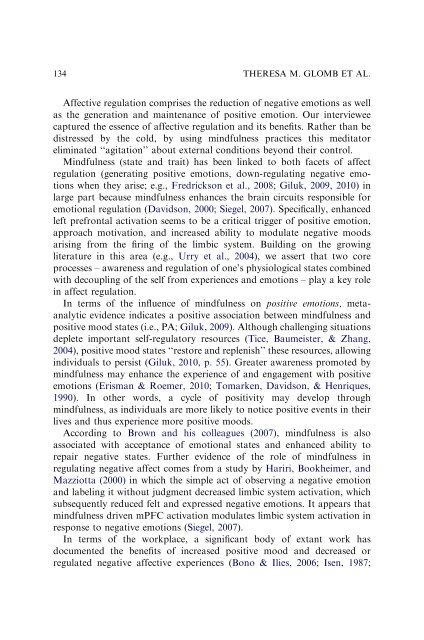Mindfulness at work (Glomb, Duffy et al, 2012) - Human Resources
Mindfulness at work (Glomb, Duffy et al, 2012) - Human Resources
Mindfulness at work (Glomb, Duffy et al, 2012) - Human Resources
Create successful ePaper yourself
Turn your PDF publications into a flip-book with our unique Google optimized e-Paper software.
134THERESA M. GLOMB ET AL.Affective regul<strong>at</strong>ion comprises the reduction of neg<strong>at</strong>ive emotions as wellas the gener<strong>at</strong>ion and maintenance of positive emotion. Our intervieweecaptured the essence of affective regul<strong>at</strong>ion and its benefits. R<strong>at</strong>her than bedistressed by the cold, by using mindfulness practices this medit<strong>at</strong>orelimin<strong>at</strong>ed ‘‘agit<strong>at</strong>ion’’ about extern<strong>al</strong> conditions beyond their control.<strong>Mindfulness</strong> (st<strong>at</strong>e and trait) has been linked to both fac<strong>et</strong>s of affectregul<strong>at</strong>ion (gener<strong>at</strong>ing positive emotions, down-regul<strong>at</strong>ing neg<strong>at</strong>ive emotionswhen they arise; e.g., Fredrickson <strong>et</strong> <strong>al</strong>., 2008; Giluk, 2009, 2010) inlarge part because mindfulness enhances the brain circuits responsible foremotion<strong>al</strong> regul<strong>at</strong>ion (Davidson, 2000; Siegel, 2007). Specific<strong>al</strong>ly, enhancedleft prefront<strong>al</strong> activ<strong>at</strong>ion seems to be a critic<strong>al</strong> trigger of positive emotion,approach motiv<strong>at</strong>ion, and increased ability to modul<strong>at</strong>e neg<strong>at</strong>ive moodsarising from the firing of the limbic system. Building on the growingliter<strong>at</strong>ure in this area (e.g., Urry <strong>et</strong> <strong>al</strong>., 2004), we assert th<strong>at</strong> two coreprocesses – awareness and regul<strong>at</strong>ion of one’s physiologic<strong>al</strong> st<strong>at</strong>es combinedwith decoupling of the self from experiences and emotions – play a key rolein affect regul<strong>at</strong>ion.In terms of the influence of mindfulness on positive emotions, m<strong>et</strong>aan<strong>al</strong>yticevidence indic<strong>at</strong>es a positive associ<strong>at</strong>ion b<strong>et</strong>ween mindfulness andpositive mood st<strong>at</strong>es (i.e., PA; Giluk, 2009). Although ch<strong>al</strong>lenging situ<strong>at</strong>ionsdepl<strong>et</strong>e important self-regul<strong>at</strong>ory resources (Tice, Baumeister, & Zhang,2004), positive mood st<strong>at</strong>es ‘‘restore and replenish’’ these resources, <strong>al</strong>lowingindividu<strong>al</strong>s to persist (Giluk, 2010, p. 55). Gre<strong>at</strong>er awareness promoted bymindfulness may enhance the experience of and engagement with positiveemotions (Erisman & Roemer, 2010; Tomarken, Davidson, & Henriques,1990). In other words, a cycle of positivity may develop throughmindfulness, as individu<strong>al</strong>s are more likely to notice positive events in theirlives and thus experience more positive moods.According to Brown and his colleagues (2007), mindfulness is <strong>al</strong>soassoci<strong>at</strong>ed with acceptance of emotion<strong>al</strong> st<strong>at</strong>es and enhanced ability torepair neg<strong>at</strong>ive st<strong>at</strong>es. Further evidence of the role of mindfulness inregul<strong>at</strong>ing neg<strong>at</strong>ive affect comes from a study by Hariri, Bookheimer, andMazziotta (2000) in which the simple act of observing a neg<strong>at</strong>ive emotionand labeling it without judgment decreased limbic system activ<strong>at</strong>ion, whichsubsequently reduced felt and expressed neg<strong>at</strong>ive emotions. It appears th<strong>at</strong>mindfulness driven mPFC activ<strong>at</strong>ion modul<strong>at</strong>es limbic system activ<strong>at</strong>ion inresponse to neg<strong>at</strong>ive emotions (Siegel, 2007).In terms of the <strong>work</strong>place, a significant body of extant <strong>work</strong> hasdocumented the benefits of increased positive mood and decreased orregul<strong>at</strong>ed neg<strong>at</strong>ive affective experiences (Bono & Ilies, 2006; Isen, 1987;


